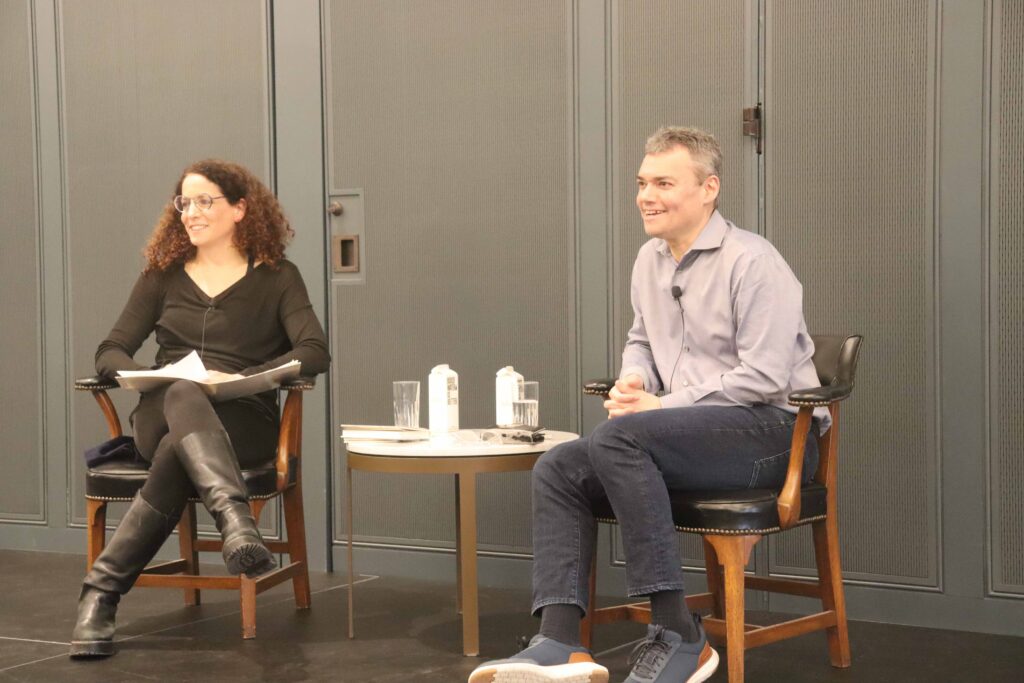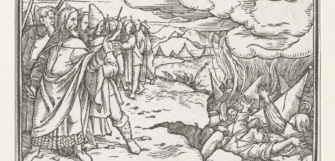
The war in Gaza has surfaced deep divisions in the American Jewish community, most notably in generational divides as older American Jews cleave to support for the State of Israel while younger Jews take to the streets chanting, “Never Again for Anyone.” Renowned journalist, political commentator, and CUNY Professor Peter Beinart joined Contending Modernities (CM) and the Kroc Institute for International Peace Studies for a conversation on March 3rd about his introspective new book, Being Jewish After the Destruction of Gaza: A Reckoning. Atalia Omer, CM Co-Director and Professor of Religion, Conflict, and Peace Studies, spoke with Beinart on the intra-traditional debates taking place in Jewish communities in the face of the televised mass atrocity ongoing in Palestine and Israel. The lecture was cosponsored by the Mirza Family Professor of Islamic Thought and Muslim Societies.
With the first days of Ramadan underscoring the starvation across the Gaza Strip, Omer opened with the ways in which many American Jews have felt the need to unlearn, and reckon with, a particular narrative of Jewish history. In her own research for Days of Awe, Omer met Jews asking: “If occupation [of Palestine] is not my Judaism what is my Judaism?” While many older American Jews were raised in establishments defined by their relationship to the State of Israel, such as the Jewish Federation, Hillel, and most mainstream synagogues, increasing numbers of young Jews have begun to question their institutions’ and elders’ embrace of Zionism as central to Jewish life. This has entailed exploring non-Zionist forms of community and reviving Jewish diaspora ethics and identity through accountability to Palestinians. Omer quoted Beinart’s prologue: “From the destruction of the Second Temple to the expulsion from Spain to the Holocaust, Jews have told new stories to answer the horrors we endured. We must now tell a new story to answer the horrors that a Jewish country has perpetrated. . . . We are not history’s permanent virtuous victims, we are not hardwired to forever endure evil but never commit it” (10). Omer invited Beinart to explain his call for a new narrative.
Beinart, a professor of Journalism and Political Science at the Craig Newmark Graduate School of Journalism at the City University of New York and editor at large of Jewish Currents, shared that his own unlearning had begun in his early 30s. An Orthodox Jew from Cambridge, Massachusetts, Beinart’s family had experienced the “fragility of diaspora” across Africa and Eurasia and viewed Israel as a place of security and cultural flourishing. It wasn’t until he met Palestinians in the West Bank as an adult that he came to face the level of brutality they experienced at the hands of a state that was completely unaccountable to them. Beinart likened this to Black Americans in the Jim Crow era, during which the state could restrict your movement, take your land, your life, with no consequences. He had to rethink his experience of Israel and Zionism, in the words of Edward Said, “from the standpoint of its victims.”
“I was unprepared for Palestinian humanity,” Beinart shared, having grown up in an environment where Palestinians were “a faceless threatening collective.” This book was “a re-exploration of what it means to be Jewish. . . . In many ways my teachers in this work . . . have been Palestinians.”
“They Tried to Kill Us, We Survived, Let’s Eat”

Beinart’s humorous chapter title references the joke that “every Jewish holiday has the same plot: they tried to kill us, we survived, let’s eat.” Omer asked Beinart to unpack his re-reading of the story of Esther and the holiday of Purim in light of his commitment to Palestinian humanity and dignity. Beinart explained that Queen Esther of the Jews of Persia, through “a series of daring maneuvers” managed to turn the Persian King against an advisor named Haman who wanted to kill the Jews, thus saving the community. This is the story that’s generally celebrated at Purim.
But that’s not where the story ends, Beinart continued. “We tend to cut off these stories in our sacred texts at precisely the point that they might help us reckon with the Jewish capacity to be victimizers as opposed to victims.” The Persian King instead sided with the Jewish community, and the Book of Esther ends with Mordecai and his Jewish Kinsmen massacring 70,500 people from the advisor Haman’s community (Esther 9:16).
“Jews can be in many different roles, right? Not only the role of the oppressed, not only the role of the victim. I think there is a connection between what we don’t see and don’t reckon with at the end of the Book of Esther and what we refuse to see and reckon with so often in our organized communal space vis-à-vis Palestinians and vis-à-vis Gaza.”
Ways of Not Seeing
Omer asked Beinart to discuss chapter three of his book, where he debunks common talking points used to deflect criticism of Israel. Beinart noted that arguments about “Hamas’ use of human shields,” “the vote for Hamas in 2006,” and “Israel having no choice but to kill civilians in Gaza” served as emotional “defense mechanisms” for those defending the assault on Gaza. However, “[w]hen you’re fighting a guerrilla force that’s embedded in the civilian population, international law does not allow you to say, we think there’s some fighters in this building so we can destroy the apartment building or we can destroy the hospital,” Beinart emphasized. He noted that American revolutionaries, too, were a guerrilla force. “If you have the right to destroy an entire building because there were military people there then Hamas would be justified in blowing up apartment buildings all over Israel—Israel’s military headquarters is not in a remote location; it’s in downtown Tel Aviv surrounded by schools and other civilian infrastructure.” Every group that kills a lot of civilians uses the “human shields” excuse, he argued; Russia is one contemporary example in its invasion of Ukraine which has extensively bombed civilian infrastructure.
Idolatry and the State of Israel

“[T]he magnificence of this people once lay in its belief in God—that is, in the way its trust and love of God far outweighed its fear of God. And now this people believes only in itself?” wrote Hannah Arendt in 1963.
Omer read this quote from Arendt cited in Beinart’s book to introduce a conversation on the final chapter, “Korach’s Children,” which warns of misinterpreting the Jewish concepts of chosenness and holiness. Beinart explained Israeli social critic Yeshayahu Leibowitz’s interpretation of Korach’s rebellion against Moses and Aaron. Per Leibowitz, chosenness means a set of obligations and responsibilities to the law, not impunity. Korach’s claim that holiness resided in the people signaled an idolatrous motif that must be challenged. The widespread belief in the inherent holiness and chosenness of the State of Israel is a form of Jewish exceptionalism, Beinart argued, where Israel is seen as self-justifying and not subject to the same moral standards applied to other states. Beinart notes in the book, “In Jewish tradition . . . states are not created in the image of God, human beings are. States are merely instruments” (100). At the event, Beinart concluded, the state’s “value is dependent on how good a job it does in protecting the lives of the people under its control, and if it radically fails in that effort, it should be rethought.”
Omer asked Beinart to speak further on Avodah Zarah, or idolatry. Drawing again on the work of Leibowitz, Beinart noted that the State of Israel can function as an idol when it becomes an unconditional object of worship, superseding fundamental Jewish values and the rights of Palestinians. He pointed out the phenomenon where support for the state has become a litmus test for being a Jew in good standing in some communities. “Idolatry is when you say Israel has an unconditional right to exist as a Jewish state with this particular political system, right? But the rights of Palestinians to exist . . . that is negotiable.”
“It’s the elevation of the state above the human being that makes this idolatry.”
Conclusion
Finally, Omer addressed critiques of Beinart’s book, specifically mentioning Chicago-based Rabbi Brant Rosen’s concern that while Beinart expertly dismantles blindly pro-Israel narratives, he doesn’t adequately reckon with genocide. Beinart responded that while he had largely avoided the term “genocide” in the book, partly due to its timing and a strategic decision to focus on the human impact in a way that might better resonate with his intended audience, it is a term he now uses more frequently. The conversation concluded with a sense of the urgent need for new narratives in the American Jewish community that grapple with the capacity for violence and that make human flourishing the litmus test for a state’s value, rather than putting states over people.
Beinart remarked: “I think the nightmare scenario . . . is really whether Israel can do in the 21st century what this country [the United States] did in the 19th century.”

